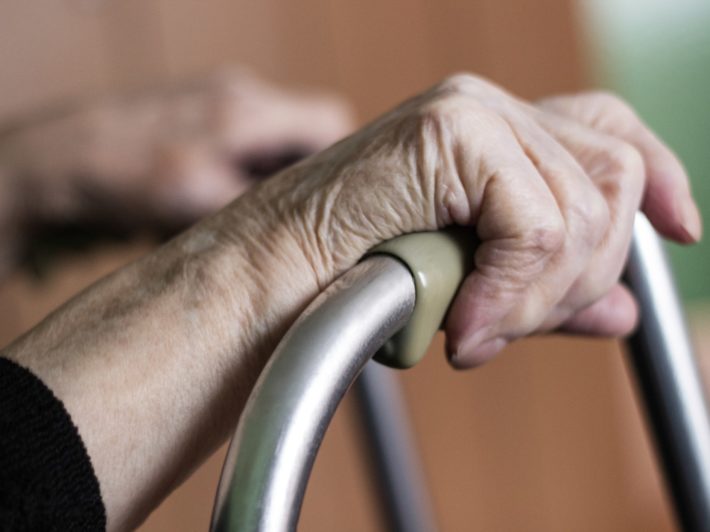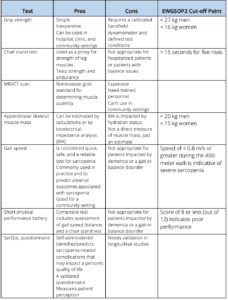
by Molly Knudsen, MS, RDN
It’s no secret: The United States is getting grayer. More gray hair, that is.
In 2018, the number of Americans 65 years and older reached 52 million.1 That number is projected to practically double to 95 million, or nearly one in every four Americans by 2060.1,2 This rise in an aging population will result in some unique challenges such as strain to the elder care resources, additional healthcare costs, and the need of addressing chronic diseases as life expectancy rises.1,2
One of the pathophysiological changes that accompany aging is loss of muscle mass and function.3 Muscle mass peaks between young adulthood and around 40 years of age.4 For some, muscle mass begins to decline around 30 years of age and the process accelerates further after age 60.
The term sarcopenia was coined to describe this muscle loss associated with aging. However, it is no longer a condition that arises in old age or exclusively impacts the elderly.
This article will summarize the most recent definitions of sarcopenia, diagnostic methods, causes and risk factors of sarcopenia, outcomes and healthcare costs, different diagnostic methods, and lifestyle recommendations to manage the condition.
What is sarcopenia?
The definition of sarcopenia was recently updated in 2018 by the European Working Group on Sarcopenia in Older People.4 This definition has three parameters: low muscle strength, low muscle quantity or quality, and low physical performance.4
Muscle strength, a reliable proxy of muscle function, is the primary indicator of sarcopenia.4 Low muscle strength indicates probable sarcopenia in a person. A true diagnosis of sarcopenia is confirmed with low muscle quantity or quality.4 And sarcopenia is considered severe when low physical performance is also noted.
It is estimated that up to 29% of community-dwelling adults over 65 years of age and 14-33% of older adults living in care facilities meet the definition for sarcopenia.5
Primary sarcopenia: Sarcopenia is considered primary when there is no other apparent or specific cause to the disease.4
Secondary sarcopenia: This type of sarcopenia is caused by factors other than aging and develops as a result of inadequate intake of energy or protein.4 Examples of these other causal factors included systemic disease, sedentary lifestyle, immobility, anorexia, malabsorption, or impaired ability to eat.4
Sarcopenic obesity: This occurs when there is a reduction of lean body mass in conjunction with excess body fat.4 Sarcopenic obesity is becoming more and more prevalent as the rates of obesity and the aging population collide.
Acute and chronic sarcopenia: The former is often brought upon by an acute illness or injury and lasts less than 6 months. When it persists for over six months, it is considered chronic sarcopenia.4
How to diagnose sarcopenia?
There are a variety of measurement tools and tests to diagnose sarcopenia. Depending on the patient, type of setting, and resources available, some diagnostic tests may be more suitable over others.
Tools for diagnosis4
What are the causes and risk factors of sarcopenia?
Sarcopenia has been recognized as an unavoidable part of graying. However, the severity and the age of onset is not predetermined by age. Disease onset is extremely variable and is dependent on several risk factors relating to muscle atrophy.
Sedentary lifestyle: A sedentary lifestyle characterized by a lack of exercise or physical activity is the most pronounced risk factor of sarcopenia.4 While there is a natural decline of muscle mass and muscle fibers with age, the progression is far more pronounced in those who lead a sedentary lifestyle compared to those who are athletes or are physically active.4
Decreased protein synthesis: Aging is associated with a lower dietary protein intake and a decrease in ability to synthesize protein.6 Decreased protein synthesis is a contributor to muscle atrophy and can result in muscle degradation, outpacing the protein synthesis needed to maintain muscle mass.7
Age-related hormonal changes: Aging is linked to a decrease in anabolic hormones like growth hormone, testosterone, and insulin-like growth factor, impacting muscle mass and strength.6
Proinflammatory cytokines: Proinflammatory cytokines like tumor necrosis factor alpha (TNF-α) and interleukin-6 (IL-6) mediate catabolic process in the body.6 This, coupled with a decrease in anabolic hormones, is an unfavorable situation for maintaining lead body tissue. Both TNF-α and IL-6 have been shown to be elevated in the muscles of older adults.8,9
Other independent risk factors: A retrospective, cross-sectional study in Japan investigated the risk factors of sarcopenia in community-dwelling adults over 60 years of age.5 Analysis of this population found that old age (75 years or older), obesity, hypertension, and malnutrition along with living in a long-term care facility and having conversations with fewer than 5 people a day were identified as independent risk factors of sarcopenia.5 This is one of the few studies to identify social engagement as a risk factor for sarcopenia and offers a unique recommendation of encouraging social activities in older populations to improve quality of life and potentially slow the progression of sarcopenia.
How do you treat/manage sarcopenia?
Research and interest in treatment methods for sarcopenia have been increasing in recent years, likely motivated by the disease outcomes, the sheer cost of treatment, and the profound prevalence of the disease.
Sarcopenia increases a person’s risk of falls and fractures, impairs a person’s ability to perform activities of daily living, is associated with other chronic conditions, impairs mobility, and can lead to a lowered quality of life.4 All of these outcomes can result in hospitalization.
Twenty years ago, the healthcare expenditure of direct medical costs of patient with sarcopenia was estimated to be $18.5 billion in the United States alone.10 And that was before the oldest portion of Baby Boomers turned 65. Sarcopenia has also been estimated to increase hospitalization costs and is associated with longer length of stays in hospitals for older adults.11,12 A systematic review of data from 2000 to 2013 estimated that up to 29% of community-dwelling adults 65 or older and 14-33% of people living in care facilities meet the definition of sarcopenia.13
And as it turns out, lifestyle factors such as exercise and nutrition are at the forefront of addressing healthcare concerns of sarcopenia.
Exercise and physical activity: While there are slight differences between exercise and physical activity (exercise is planned, structured activity, and physical activity refers to any form of bodily movement), they are both some of the most effective interventions for sarcopenia and healthy aging in general. Exercise has positive influences on muscle mass and strength, as well as metabolism and inflammation.14
Protein: Randomized controlled trials (RCTs) indicate that protein consumption plays a vital role in preventing or delaying the onset of muscle loss and sarcopenia.10 A 2018 double-blind RCT investigated the impact of a 12-week, 3-arm intervention where frail, elderly participants 70 to 85 years of age were assigned to receive either 0.8, 1.2, or 1.5 grams per kilogram of bodyweight (g/kg) per day.15 Interestingly, results showed that only those in the 1.5 g/kg group had significant improvements in muscle mass, and there was no significant difference between the 0.8 and the 1.2 g/kg per day group, indicating that a higher protein intake of 1.5 g/kg per day may be more beneficial in this group.
A cohort study also found that older adults’ failing to meet protein intake recommendations was associated with significantly lower measures of lean muscle mass.16
Leucine: Leucine is a branched-chain amino acid (BCAA) that is one of the most crucial essential amino acids for regulating muscle protein synthesis.14 With age, people aren’t as efficient at building muscle, especially with less than 10 g of essential amino acids (EAAs) at a time. However, slightly higher doses of 10-15 g of protein with leucine contributing at least 3 g has been shown to be sufficient in generating a protein anabolic response.14,17 Soybeans, peanuts, and lentils are all foods that are rich in leucine.
Vitamin D: Data is emerging on the role that vitamin D plays in the development and treatment of sarcopenia. One RCT conducted in a Lebanese population found that individuals with both sarcopenia and vitamin D deficiency showed significant improvements in appendicular skeletal muscle mass (ASMM) after supplementation with 10,000 IU of cholecalciferol per day for six months compared to a placebo group.18 While this data is promising, the dose, length of supplementation, and direct impact of improving muscle mass and function is still unknown.10
Omega-3 fatty acids: Omega-3s are known for their anti-inflammatory properties, and supplementation of these fatty acids is now being studied in skeletal muscle health for older adults. Most research thus far has focused on healthy individuals. One RCT found that 3.9 g of omega-3 supplementation per day for 16 weeks significantly reduced oxidant emissions and enhance postabsorptive muscle protein synthesis.19 Another RCT investigated the effects of omega-3 supplementation (3.36 g of fish oil per day) for six months compared to a placebo of corn oil.20 Those in the omega-3 group had significantly increased thigh muscle volume and hand-grip strength compared to the placebo group.
Mediterranean diet: Cross-sectional and longitudinal studies have found that adherence to a Mediterranean diet is positively associated with protective measures for sarcopenia such has skeletal muscle mass and walking speed.21,22 The Mediterranean diet is rich with lean, high-quality protein, olive oil, nuts, seeds, legumes, and vegetables.
Antioxidants: Antioxidants like curcuminoids from turmeric, catechins and polyphenols from green tea, and vitamin C may be beneficial in the prevention and treatment of sarcopenia.10 While human data on the role of antioxidants on sarcopenia is limited, oxidative stress is speculated to play a role in sarcopenia.10
Combined lifestyle approaches
Yes, consuming certain nutrients has shown significant beneficial effects for treating and preventing sarcopenia on their own, but combining interventions with multiple aspects of these lifestyle approaches has a synergistic effect on measures of sarcopenia.
A double-blind RCT of 380 individuals 65 years and older found that those who consumed a nutritional supplementation of 20 g of whey protein, 3 g of leucine, and 800 IU of vitamin D for 13 weeks showed significant improvements in chair-stand test scores and appendicular muscle mass compared to those in the placebo group (who received an isocaloric supplement).23
A 2019 study of an elderly, sarcopenic Japanese population randomized participants into one of four groups: resistance exercise and nutritional supplementation, exercise alone, nutritional supplementation alone, or control.24 The combined group who received 12 weeks of nutritional supplementation of 10 g of whey protein and 800 IU of vitamin D along with two 30-minute resistance exercise sessions per week had the greatest improvement in muscle quality and strength compared to those in the control and those in the exercise-only or nutritional supplementation-only group.24
What’s missing in the literature, though, is long-term data on approaches to sarcopenia in community-dwelling older individuals. The Sarcopenia and Physical fRailty IN older people: multi-component Treatment strategies or SPRINTT project was designed to address that gap.25 The SPRINTT project is the largest clinical trial investigating a multicomponent approach to prevent sarcopenia. The goal of this study is to recruit 1,500 participants 70 years or older across Europe who will be randomized to either a multicomponent intervention or an education group for up to three years.25 Results from this study will provide key insights to sarcopenia prevention recommendations.
Summary
Sarcopenia is not an inevitable part of aging. It can be halted or greatly slowed. As the aged population in the US and the world rises, sarcopenia prevention and treatment become especially important. A combination of resistance exercise, high-quality protein paired with additional leucine supplementation, and vitamin D appears to be a comprehensive approach of addressing sarcopenia. However, there is no consensus in the literature on the quantity and duration of these interventions, but healthcare practitioners can use this literature to make informed recommendations to patients based on their personalized needs.
Citations
- Fact Sheet: Aging in the United States. Prb.org. https://www.prb.org/aging-unitedstates-fact-sheet/. Published July 15, 2019. Accessed January 19, 2021.
- Vespa J. The Graying of America: More Older Adults Than Kids by 2035. Census.gov. https://www.census.gov/library/stories/2018/03/graying-america.html. Published March 13, 2018. Revised October 8, 2019. Accessed January 19, 2021.
- Ogawa S et al. Age-related sarcopenia and its pathophysiological bases. Inflamm Regen. 2016;36:17.
- Cruz-Jentoft AJ et al. Sarcopenia: revised European consensus on definition and diagnosis. Age Ageing. 2019;48(1):16-31.
- Kurose S et al. Prevalence and risk factors of sarcopenia in community-dwelling older adults visiting regional medical institutions from the Kadoma Sarcopenia Study. Sci Rep. 2020;10:19129.
- Dhillon RJS et al. Pathogenesis and management of sarcopenia. Clin Geriatr Med. 2017;33(1):17-26.
- Gordon BS et al. Regulation of muscle protein synthesis and the effects of catabolic states. Int J Biochem Cell Biol. 2013;45(10):2147-2157.
- Bian Ai-Lin et al. A study on relationship between elderly sarcopenia and inflammatory factors IL-6 and TNF-α. Eur J Med Res. 2017;22:25.
- Ryall JG et al. Cellular and molecular mechanisms underlying age-related skeletal muscle wasting and weakness. Biogerontology. 2008;9(4):213–228.
- Ganapathy A et al. Nutrition and sarcopenia—What do we know? Nutrients. 2020;12(6):1755.
- Sousa AS et al. Sarcopenia and length of hospital stay. Eur J Clin Nutr. 2016;70(5):5995-5601.
- Antunes AC et al. Sarcopenia and hospitalisation costs in older adults: a cross-sectional study. Nutr Diet.2017; 74: 46–50.
- Cruz-Jentoft AJ et al. Prevalence of and interventions for sarcopenia in ageing adults: a systematic review. Report of the International Sarcopenia Initiative (EWGSOP and IWGS). Age Ageing. 2014;43(6):748-759.
- Martone AM et al. Exercise and protein intake: A synergistic approach against Sarcopenia. Biomed Res Int. 2017;2017:2672435.
- Park Y et al. Protein supplementation improves muscle mass and physical performance in undernourished prefrail and frail elderly subjects: A randomized, double-blind, placebo-controlled trial. Am J Clin Nutr. 2018;108:1026–1033.
- Scott D et al. Associations between dietary nutrient intake and muscle mass and strength in community-dwelling older adults: The Tasmanian Older Adult Cohort study.J Am Geriatr Soc. 2010;58:2129–2134.
- Xu ZR et al. The effectiveness of leucine on muscle protein synthesis, lean body mass and leg lean mass accretion in older people: a systematic review and meta-analysis. Br J Nutr. 2015;113(1):25-34.
- El Hajj C et al. Vitamin D supplementation and muscle strength in pre-sarcopenic elderly Lebanese people: A randomized controlled trial. Arch Osteoporos. 2019;14:4.
- Lalia AZ et al. Influence of omega-3 fatty acids on skeletal muscle protein metabolism and mitochondrial bioenergetics in older adults. Aging. 2017;9:1096.
- Smith GI et al. Fish oil–derived n− 3 PUFA therapy increases muscle mass and function in healthy older adults. Am J Clin Nutr. 2015;102:115–122.
- Kelaiditi E et al. Measurements of skeletal muscle mass and power are positively related to a Mediterranean dietary pattern in women. Osteoporos Int. 2016;27(11):3251-3260.
- Shahar DR et al Adherence to Mediterranean diet and decline in walking speed over 8 years in community-dwelling older adults. J Am Geriatr Soc. 2012; 60(10):1881-1888.
- Bauer JM. Effects of a vitamin D and leucine-enriched whey protein nutritional supplement on measures of sarcopenia in older adults, the PROVIDE study: A randomized, double-blind, placebo-controlled trial. J Am Med Dir. 2015;16:740–747.
- Yamada M. Synergistic effect of bodyweight resistance exercise and protein supplementation on skeletal muscle in sarcopenic or dynapenic older adults. Geriatr Gerontol Int. 2019;19:429–437.
- Marzetti E et al. Innovative medicines initiative: the SPRINTT project. J Frailty Aging. 2015;4(4):207–208.
Molly Knudsen, MS, RDN completed her dietetic training with an emphasis on nutrition education at Texas Christian University and earned a Master of Science in Nutrition Interventions, Communication, and Behavior Change from the Friedman School of Nutrition Science and Policy at Tufts University. Knudsen has experience working with commodity boards and providing student athletes with nutrition coaching. She now practices nutrition education by digesting complex nutrition science through the written word.








